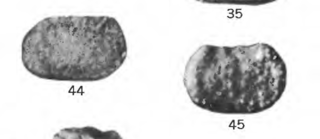This list of prehistoric ostracods is an attempt to create a comprehensive listing of all genera from the fossil record that have ever been considered to be members of the Ostracoda, excluding purely vernacular terms. The list includes all commonly accepted genera, but also genera that are now considered invalid, doubtful ( nomina dubia ), or were not formally published ( nomina nuda ), as well as junior synonyms of more established names, and genera that are no longer considered ostracods.
Graphiadactyllis is an extinct genus of ostracod belonging to the family Quasillitidae and order Podocopida. Specimens have been found in Mississippian to Permian beds in North America, Europe, and Australia.

Amphissites is an extinct genus of ostracod belonging to the suborder Beyrichicopina and family Amphissitinae. Species belonging to the genus lived from the Devonian to the Permian in Europe, North America, Australia, and east Asia. The genus were likely deposit-feeders, and may have survived briefly into the Triassic.

Aurikirkbya is an extinct genus of ostracod belonging to the suborder Beyrichicopina and family Kirkbyidae. It is found in Pennsylvanian to Triassic beds in North America, east Asia, southwest Asia, and Europe.
Ceratobairdia is an extinct genus of ostracod belonging to the order Podocopida and family Bairdiidae. Specimens have been found in Permian to Jurassic beds in North America, China, and Europe.
Polytylites is an extinct genus of ostracod belonging to the order Palaeocopida and family Amphissitidae. Specimens have been found in beds of Carboniferous to Permian age in North America and Asia.

Roundyella is an extinct genus of ostracod belonging to the order Leperditellocopida and family Scrobiculidae. Specimens have been found in beds of Devonian to Triassic age in Australia, Asia, Europe, North America, and South America.